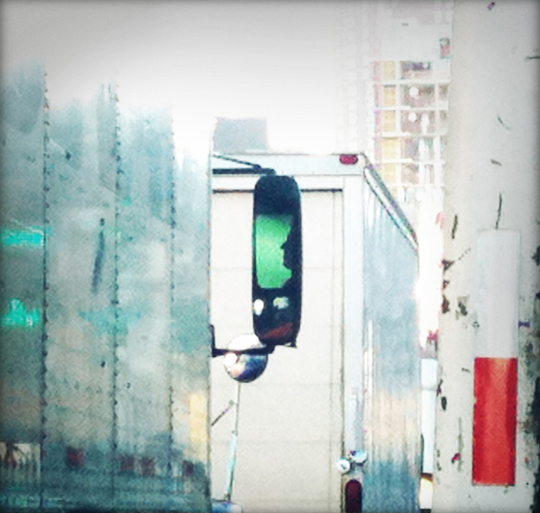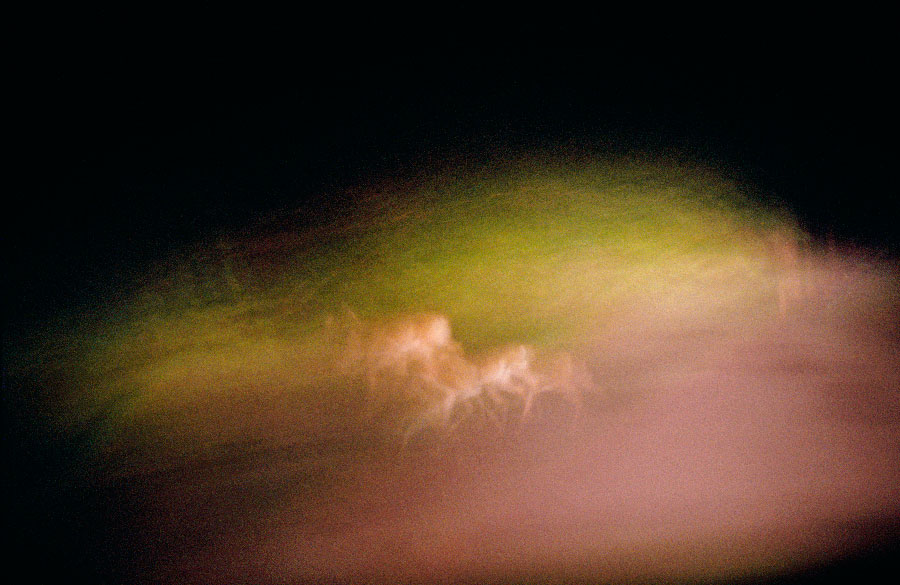"One of the things my father taught me, was that photography is always about the subject, the photographer and photography itself" Henry Jacobson.
Former Magnum photographer, Jeff Jacobson, and his son Henry hold a mirror to the recent history of photography and the impact of digital within their work. Set to publish new, individual photobooks with Daylight this winter, both The Last Roll (Jeff) and Postcards Home (Henry) share highly personal narratives as Jeff and Henry photograph tumultuous times in their lives. Whilst The Last Roll corpus acts as an acknowledgement of the passing of Kodachrome – the film that made his career, Postcards Home reimagines the value of photographs through the new digital medium, mobile.
The two photobooks also document the changing face of publishing, as Henry strives to raise the funding for the book through the crowdfunding platform, Kickstarter. Now on the home stretch with only 3 days to go, I caught up with the father and son duo to find out more about the projects.
Jeff Jacobson: The Last Roll started in the beginning of 2004 when I was diagnosed with lymphoma. We had this house in the Catskills about two and a half hours Northwest of New York City, so when I was going through chemotherapy I would go up there to recuperate and I found that I started photographing around the house. It was a whole new milieu of shooting for me – I had never shot that close to home before. As I got better, I started travelling again, but all in the United States.
About a year or so later, Kodak announced that they were discontinuing Kodachrome, which was the film I had always shot on throughout my career – so I bought massive amounts of the stuff and shot right up until the end of 2010 when all the processing of Kodachrome ended. This body of work really spans from the beginning of 2005 to the end of 2010. For me, it’s just when you are confronted with mortality – both physical mortality and creative mortality – you have to do something – and this is what I did.
Henry Jacobson: Similarly, mine came out of a life event – the first pictures of the Postcards Home were taken in the few moments before I left my marriage.
The earliest picture in the book, which was the very beginning of 2010, and for a little over two years, I was completely nomadic – just going from job to job and not keeping an apartment or residence at all. About a year into it, I started to really develop, a personal connection to shooting on my iPhone. I started seeing patterns in the way I was shooting and then, throughout all that travel, I was taking a picture and within moments or hours (at least) I was sending it back to parents, friends and loved ones. As it evolved, I started to realise that connection, that connectivity, became more of a sense of home and place to me than a physical location. As I thought about it more I realised that is the nature of mobile photography in the way that it has changed our perception of photography.
People think of it now, because so many people use this technology, as essentially a form of communication rather than as a record of their lives. People put up on Instagram, send each other pictures as a hello, ‘this is what I’m doing right now’ rather than huge photo albums. So really, it’s me exploring that landscape and that new version of photography.
Natalie Lloyd: I think what is really interesting about your two bodies of work is that there are so many crossovers between your relationships with photography. Jeff, Henry mentioned that you were one of the people on the receiving end of these mobile phone pictures – what is your relationship with mobile photography – specifically coming from your son – how do you see this form of ‘photography’ coming from more of a traditional practice?
JJ: Well, you know when Kodachrome was ending I had to figure out what I was going to do next. I was intrigued by the idea of this iPhone, but that was just as Henry was starting to take these pictures. So I said to myself, “Oh no, I can’t do that because Henry is doing it and you know – I don’t want to blow him out of the water with my pictures!” Well really quickly, very quickly… Disturbingly quickly – I saw what he was doing and realised that was not the problem! The problem would be that I would be blown out of the water by what he was doing, because I thought he was really onto something.
On a certain level, he was making the kinds of pictures with his iPhone that I had always dreamed of making with film. It’s not that I didn’t like what I was doing with film, it’s just that I really liked what he was doing on his phone. I went in a slightly different direction, but also with a small digital camera, because of the things that I really love about Henry’s iPhone pictures – so much of what I see with iPhone that people my age or so called ‘Photojournalists’ or so called ‘documentary photographers’ are doing, is that they try to recreate what they’ve always done either in film or in SLR digital with the iPhone. Well, Henry’s not doing that, he’s been doing something very different. He’s using that iPhone and that really low resolution for what it’s really good for – he’s emphasised that.
I’ve been shooting with a little Lumix digital camera and it’s the same thing, it’s a bigger file than an iPhone – but it’s the portability of it, it’s that I can go anywhere with it and shoot anywhere. I pick up this little camera on the subway or on the street and everyone just thinks that I’m a tourist – just another person with a little camera. No one pays any attention to me. If I was out there with a big SLR, the minute I pick this camera up, people are going to look at me.
HJ: Yeah, that’s actually one of the things I love about it. It’s so intimate. I think more than any other project, more than anything I’ve done before, including any fashion work – which I’ve done very stylised – it’s the most personal. I have found a personal expression, a textural quality to the camera.
JJ: It’s interesting that he says “textural” relationship, because that’s one thing that links these two bodies of work. I always used the fast speed Kodachrome 200 and pushed it two stops so it creates this texture with the grain – so there’s this textural quality to these pictures in Kodachrome that I’m publishing and in some strange way, is very similar to the textural quality with these iPhone pictures.
NL: I completely agree, it’s that quality of digital noise that’s inherent in the medium and the subtlety of that quality in the images that does hold a very strong relationship to that original film grain – and even the colours that come out of Kodachrome are similar. I think what’s also interesting is that you, Henry, chose the fact that it’s more personal as one of the reasons why you like this way of shooting so much – and for both of you, you’ve used photography to explore very personal times in your lives. What do you think about your relationships with photography in that sense, in the fact that you’ve used it in these very intimate times in your life?
HJ: What’s interesting is that one of the things that my father taught was that any photograph is always about three things: it’s always about the subject, the photographer and photography itself. I think that’s the case for this work, it’s just a question of ratios. For me, this work is very much about photography itself – as well as I think his is – because it’s about the end of an era in photography that really defined colour for years. It really created what people think of as colour – it was people’s family albums, when people started shooting in colour; it was the most popular form. That’s another relationship between the two because now this is the most popular form in the world. I think that people who deny that relationship in any one image are lying to themselves, that any image is just about a subject; like in photojournalism where you’re “just” reporting what’s happening. I think the reason why I want to do work that is personal in photography is because I’m acknowledging the inherent nature of the medium – the drive towards doing it. I think anybody’s drive towards doing it is some kind of relationship to their own personal needs – whether you’re a photojournalist, a fine artist, even a fashion photographer. For me personally, it did come out of a particularly tumultuous time in my life. That became the boundary of the body of work.
JJ: I made my living, for the most part over the years, working for magazines as a photojournalist, but I was always following a personal agenda. Now when I started off, that agenda had a lot more to do with the outside – the political feelings about the world whereas as I got older my motivations for making photographs have become less narrative and less specific but are hopefully more universal in their feeling. But I totally agree that, all good photography is about those three things.
Think about the lack of what you put in the frame – I don’t care what kind of photography you’re making, but considering ‘Is the frame here, or here’ – that’s a very personal decision that can be made in a split second. For me, that’s what makes photography interesting: what does a photographer choose to include at a specific moment in time.
NL: Do you both see photobooks as a way of validation within the industry if you have a publisher attached to you? Do you think that’s an important statement to make as a career photographer?
HJ: Yeah I do. Creating the book with this work, really brings it back into photography rather than communication. I love photobooks, I’ve always – I grew up around them, my Dad has a huge library that I grew up looking through. I love that it’s an object; that’s physical, that expresses the photographer’s idea in that moment in time and stays constant throughout – it’s an object and a sequence that doesn’t change. This is the first time I’ve done it and these decisions are nerve wracking; agonising over which pictures are going to go next, what picture are you going to take in, leave out and ultimately does it even matter, is anybody going to tell the difference? But then you look at a great book like The Americans or Travelog and when a book gets it right, it’s so perfect. It brings you along through this journey, through the photographer, that you’re unable to find outside of the photobook.
Henry Jacobson’s Postcards Home was successfully crowd-funded in December 2012, you can find more information about the publication here. His father’s book, The Last Roll has been published by Daylight and the images are on exhibition at the Center for Photography at Woodstock through June 16, 2013.
Published on 15 December 2012
Submitted by Natalie Lloyd
Edited by Photoworks


